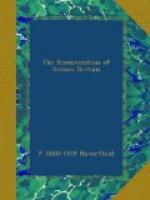All this must have contributed to the reintroduction of Celtic national feeling and culture. A Celtic immigrant, it may be, was the man who set up the Ogam pillar at Silchester (Fig. 21), which was discovered in the excavations of 1893.[1] The circumstances of the discovery show that this pillar belongs to the very latest period in the history of Calleva. Its inscription is Goidelic: that is, it does not belong to the ordinary Callevan population, which was presumably Brythonic. It may be best explained as the work of some western Celt who reached Silchester before its British citizens abandoned it in despair. We do not know the date of that event, though we may conjecturally put it before, and perhaps a good many years before, A.D. 500. In any case, an Ogam monument had been set up before it occurred, and the presence of such an object would seem to prove that Celtic things had made their way even into this eastern Romanized town.
[Footnote 1: Archaeologia, liv. 233, 441; Rhys and Brynmor Jones, Welsh People, pp. 45, 65; Victoria Hist. of Hampshire, i. 279; English Hist. Review, xix. 628. Whether the man who wrote was Irish or British depends on the answer to the question set forth in the preceding note. Unfortunately, we do not know when the Ogam script came first into use. Professor Rhys tells me that the Silchester example may quite conceivably belong to the fifth century.]
[Illustration: FIG. 21. OGAM INSCRIPTION FROM SILCHESTER.]
But a more powerful aid to the revival may be found in another fact—that is the destruction of the Romanized part of Britain by the invading Saxons. War, and especially defensive war against invaders, must always weaken the higher forms of any country’s civilization. Here the agony was long, and the assailants cruel and powerful, and the country itself was somewhat weak. Its wealth was easily exhausted. Its towns were small. Its fortresses were not impregnable. Its leaders were divided and disloyal. Moreover, the assault fell on the very parts of Britain which were the seats of Roman culture. Even in the early years of the fourth century it had been found necessary to defend the coasts of East Anglia, Kent, and Sussex, some of the most thickly populated and highly civilized parts of Britain, against the pirates by a series of forts which extended from the Wash to Spithead, and were known as the forts of the Saxon Shore. Fifty or seventy years later the raiders, whether English seamen or Picts and Scots from Caledonia and Ireland, devastated the coasts of the province and perhaps reached even the midlands.[1] When, seventy years later still, the English came, no longer to plunder but to settle, they occupied first the Romanized area of the island. As the Romano-Britons retired from the south and east, as Silchester was evacuated in despair[2] and Bath and Wroxeter were stormed and left desolate, the very centres of Romanized life were extinguished. Not a single one remained an inhabited town. Destruction fell even on Canterbury, where the legends tell of intercourse between Briton or Saxon, and on London, where ecclesiastical writers fondly place fifth- and sixth-century bishops. Both sites lay empty and untenanted for many years. Only in the far west, at Exeter or at Caerwent, does our evidence allow us to guess at a continuing Romano-British life.




